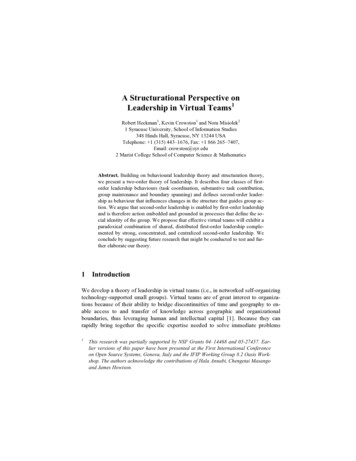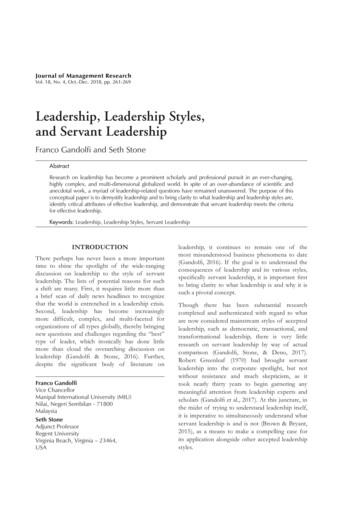Small Group And Leadership Team Resources For Churches
Small Group and Leadership TeamResources for ChurchesThis appendix gives you a few tested resources for use in churches,leadership teams, and small groups to help you lead your group tomissional engagement and impact. These resources have been usedthrough the Church Evangelism Initiative in many churches locatedin many contexts, including urban, suburban, and rural.You can also download these resources on the Church EvangelismInitiative site of the Billy Graham Center at Wheaton College. Thesefew resources give you a taste, but we have many more for churchesand leaders who join our cohorts. If you are interested in exploringjoining one of our pastor and leader cohorts, which connect you toresources, coaching, and connecting to exemplar pastors and churches,you can find information on our Church Evangelism Initiative websiteat ceicohorts.com.
One Degree Rule Worksheet 2017 Rick Richardson and Beth Seversen. Use only with permission.Use this card to fill out your temperature, write what has beenencouraging for you in outreach, and think about how to increaseyour temperature in the next month. Then practice one-degree sharingwith each other, using this card and your responses. Give each persona time limit (one to two minutes).Evangelistic TemperatureKevin Harney writes,When we are a ten, we pray often, notice people who are spiritually wandering, and enjoy making time in our schedule toconnect with those who are far from God. In these seasons, ourlights are shining, we speak of our faith often, we share storiesof what God is doing in our lives, and we share the gospel naturally. When our personal evangelistic temperature is at one, ourhearts have cooled off, we are no longer praying for lost people,and we have become too busy with church programs or ourpersonal interests to make space for people who are outside ofGod’s family. We walk right past opportunities to let the lightof Jesus shine and hardly notice. We rarely tell others about ourfaith, and we do not feel much urgency to communicate thegospel of Jesus. We are ice cold.1
3One Degree Rule WorksheetDetermining Your Personal Outreach Temperature1Apathy orevenhostility23Growingheartawareness,prayer foroutreachDate ns67Increasingspiritualconversationswith unchurchedWhat step or experienceor story encouraged melast month?89Extendinginvitations toChrist and hiscommunity10SeeingpeoplecommitWhat do I plan to do to raisemy outreach temperaturenext month?
Developing a Prayer List 2017 Rick Richardson and Beth Seversen. Use only with permission.FRANC ModelTalk through each of the following thought starters for people withwhom we are in relationships and whom God may be putting on ourheart to reach out to:1. Friends2. Relatives3. Acquaintances (especially third space and compassion)4. Neighbors (by geography and interests)5. CoworkersStart your spiritual influence list, your BLESS List, which you canuse to begin to pray daily. God’s mission is to reach the world byblessing the world through God’s people (see Gen 12:1-3). Listen toGod and journal prayers for the top five people God lays on your heart.Then pray in pairs for the Holy Spirit’s work in their life and for opportunities to share and care for them.1. :2. :3. :4. :5. :
BLESS Planning WorksheetGive people time to fill out the planning sheet below and then taketime to share and pray in pairs for personal BLESS plans, and thendiscuss your church’s vision and next steps as a group. BLESS standsfor Begin with prayer, Listen, Eat, Serve, Story.1. What have you personally done this year with the five BLESS missional practices, whether you called them that or not? What worked?What didn’t? What could have been improved?2. What are your personal challenges in implementing the BLESS missional practices?3. What are your hopes, thoughts, or dreams about what you would liketo do with the BLESS missional practices this next year personally?Brainstorm possibilities!
BLESS Planning Worksheet64. Which of these possibilities excites you the most? What is your biggestbarrier? What steps would you need to take to implement your topthree ideas?5. What are your hopes, thoughts, or dreams about what you would liketo do with the BLESS missional practices as a church or small groupcommunity? Brainstorm possibilities!6. What is your next step as a group in moving your church forward withthe BLESS missional practices? How can you begin with prayer foryour pursuit of the BLESS practices as a group, and how will you keepeach other encouraged and accountable?Discuss and pray as a group.If you are interested in downloading and using a simple small groupguide on the BLESS practices, you can download it at covchurch.org/evangelism/bless.
Church Warmth AssessmentUse the questions that follow to briefly assess the current relationaltemperature of your church and your worship service. The goal is notnecessarily to focus your services on unchurched visitors but to practicewarm and intentional hospitality toward them. Unchurched people inAmerica still tell us that the worship service is the first place they wouldvisit if they chose to connect to a congregation. For each statement,circle the number on the continuum that best describes your response.1. Our website (the new front door for churches) addresses unchurchedpeople in ways that attractively communicate acceptance and welcomewherever people are coming from.1234Icy5678RoomTemperature910FiresideWarmth2. Parking is easy to find, clearly marked, and rmth3. We have good signage that enables visitors to locate services and events.1Icy2345RoomTemperature678910FiresideWarmth
8Church Warmth Assessment4. Greeters are intentional but not pushy about trying to make visitorsfeel welcomed and wanted when they first enter the 5. The call to worship and singing intentionally address visitors in a welcoming and nonpressured way.1234Icy5678RoomTemperature910FiresideWarmth6. Aspects of the service that are primarily for committed Christians(such as the offering and Communion) are led with clear and nonjudgmental instructions, and they give visitors freedom to participate or not.1234Icy5678RoomTemperature910FiresideWarmth7. Sermons are clearly and intentionally crafted to include and addressboth unchurched visitors and committed rmth8. It is easy for visitors to find a next-step opportunity quickly to connectrelationally with others in the church.1Icy2345RoomTemperature678910FiresideWarmth
9Church Warmth Assessment9. Our church has thought through all the transitional moments in thewhole worship experience that might feel awkward to unchurchedvisitors (e.g., parking and entering, finding where kids are supposed togo, the moments before the service starts, the meet-and-greet timeduring the service, the dismissal to another activity, food and fellowship,to retrieve kids, and to 10. It is normal and routine for the pastor, other church leaders, and congregants to share their struggles, doubts, hurts, and failures in thecontext of services and other 11. We have done all we can to make the aesthetics of our location,worship spaces, and meeting spaces as attractive and welcoming rmth12. At least 5 percent or more of our attendance at weekend services isunchurched visitors (just make your best guess here).1Icy2345RoomTemperature678910FiresideWarmth
10Church Warmth Assessment13. Our people are consistently enthusiastic about inviting their unchurched friends to visit the church or to visit a key entry-point ministry of the 14. Regular attenders consistently invite visitors to attend events, havemeals together with them, or connect in other informal . First-time visitors have easy access to clear information and materialson how to take next steps to further connect with other people andopportunities at the church.1Icy2345RoomTemperature678910FiresideWarmth
11Church Warmth AssessmentTransfer the numbers you circled for each ofthe questions to the chart below. Add all thenumbers and write the total in the space provided. Divide the total by 15 to determine theaverage relational temperature (warmth factor)of your church. What stood out most to you about yourchurch’s average relational temperature?For example, is it higher or lower than youthought? Or did any of the factors thatcontribute to warmth surprise you? In what areas does your church alreadydemonstrate relational warmth well? In what areas does your church most needto raise its relational warmth temperature? If you are a small group or a leadershipteam, what steps could you take individually or as a group to increase the relational warmth of your church services?The key: warmth grows slowly. If we can keepcultivating warmth over time, it will happen.My Total 15 averagerelationaltemperature 15 You could do a similar assessment for each of your ministries andsmall group.
Note1 Kevin G. Harney, Organic Outreach for Churches: Infusing Evangelistic Passion into Your Congregation (Grand Rapids: Zondervan, 2011), 118.
Initiative site of the Billy Graham Center at Wheaton College. These few resources give you a taste, but we have many more for churches and leaders who join our cohorts. If you are interested in exploring joining one of our pastor and leader cohorts, which connect you to resources, coaching, and connecting to exemplar pastors and churches,
team xl team 2. t050710-f xl team 3. t050907-f xl team xl team 4. t050912-f xl team xl team 5. t050825-f xl team xl team 6. t050903-f xl team. 2 7. t050914-f xl team xl team 8. t061018-f xl team 9. t061105-f xl team name xl team 10. t060717-f xl team xl team 11. t070921-f xl team xl team xl team 12. t061116-f xl team. 3 13. 020904-f name/# xl .
Leadership, Servant Leadership, Situational Leadership, Authoritarian Leadership, and Moral Leadership. Although each of these styles had some very positive characteristics, it was found that Spiritual Leadership allowed for various leadership approaches to be applied as needed and these approaches were designed
Round 3 Game 1 Game 2 Game 3 Game 4 Team 1 Team 7 Team 8 Team 2 Team 6 Team 5 Team 4 Team 3 Continuing the method, which team plays Team 7 in Round 4? Team . 14 Infection Model This is a simple example of how people in a community might become infected with a disease. O
team leadership apprenticeship Our Team Leadership Apprenticeships are certified by the Chartered Management Institute (CMI). If your role involves managing an individual or a team of people, this programme is absolutely designed for you. In Summary, this Level 3 Team Leadership programme covers: - Managing People Negotiation & Influencing
(1) leadership in self-managing teams and shared leadership, informed by functional behavioral leadership theory, and (2) the emerging literature on leadership in virtual teams. These views of leadership depart from much of “traditional” leadership theory (e.g., trait theory, contingency and situational leadership theories, social exchange
Team Leadership Team Problem Solving Team Relationships Team Member LaFasto, F., & Larson, C. (2001). When teams work best: 6000 team members and leaders tell what it takes to succeed. Thousand Oaks, CA: Sage. Lencioni, P. (2002). The five dysfunctions of a team: A leadership fable. San Francisco: Jossey-Bass. Status ego Low standard Ambiguity
Source: 2016 Miami-Dade County Infant Mortality Analysis Highest Neighborhood Rates and Percentages. 31 21.6 23.7 26.26 37.84 41.84 42.28 43.74 50.7 54.06 58.9 64.56 68.34 77.04 0 20 40 60 80 100 Group F Group D Group N Group G Group B Group H Group C Group M Group J Group A Group E Group K Group I Percent p
Leadership, Leadership Styles, and Servant Leadership Franco Gandolfi and Seth Stone Abstract Research on leadership has become a prominent scholarly and professional pursuit in an ever-changing, highly complex, and multi-dimensional globaliz























